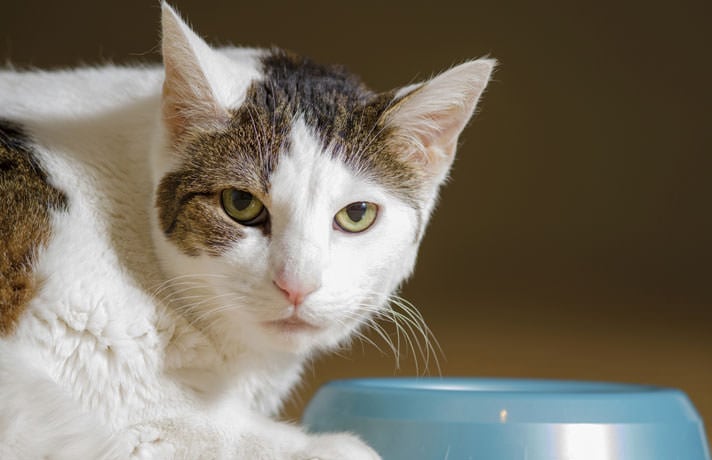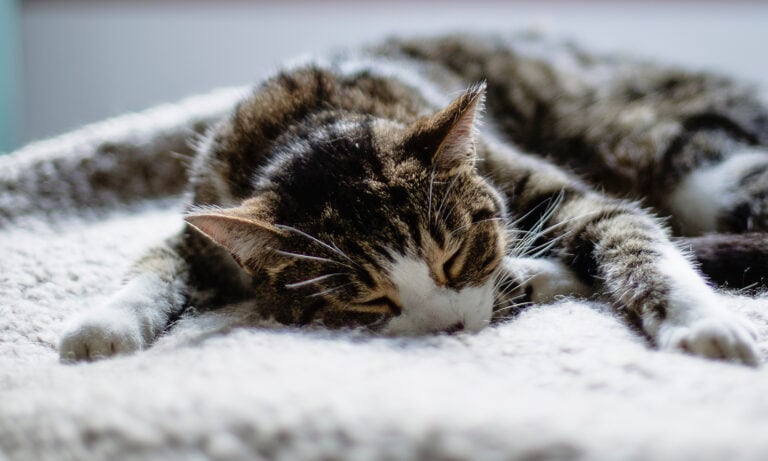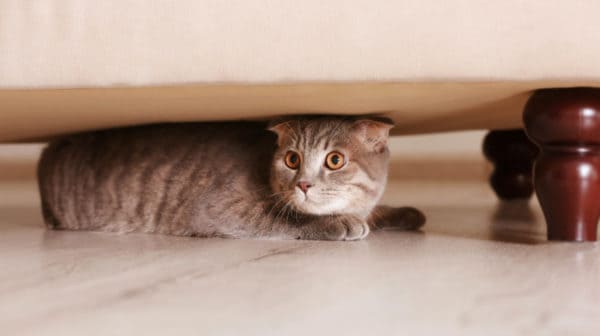When cat food turns your snuggle kitty into an attack cat, she may suffer from food aggression, a relatively uncommon type of cat aggression. Any type of aggression in cats can be dangerous to you or other pets. But how can you avoid mealtime triggers? After all, cats have to be fed.
It’s pretty common for hungry cats to get pushy around the cat food bowl My year-old Karma-Kat is somewhat food-obsessed. He still tries to eat the other cat’s old-lady food, routinely opens the pantry door to forage, gnaws holes in the dog food bag, and even has stolen food off our plates! My husband had to chase him down to retrieve his kabob once (the 10-second rule was applied).
How do you know if your cat is a foodie-focused forager? When does normal tip over into obsession?
Your Cat May Be Food Obsessed If She:
- Complains and constantly pesters when her cat bowl is empty.
- Begs at the table like a (gasp!) dog.
- Steals food or eats through packaging.
- Bullies other pets away from their food.
- Hisses or growls as she eats.
- Guards the bowl or its location.
- Attacks when food is present.
Reasons Feline Food Focus Happens
Why are some cats so obsessed with food, while others snub the bowl? There are no black-and-white answers. Studies of dogs link nutrition and the association of the neurotransmitter serotonin with aggression, but we don’t have this research available for cats.
Dr. Paolo Mongillo of the University of Padua in northern Italy believes some cases are all in the cat’s head. His study published in the “Journal of Veterinary Behavior” in 2012 claimed to document the first confirmed case of feline food obsession and named the condition “psychogenic abnormal feeding behavior.” Behavior modification techniques managed to stop the behavior.
Your cat may have a combination of reasons for the behavior, though.
Hungry Habit
It’s perfectly normal for hungry cats to meow and pester you to fill the bowl. Giving in to the plea reinforces the behavior and tells the cat, “Pestering works!”
Kitty Competition
Cats learn to guard and protect resources when there’s not enough to go around. Multi-pet homes are more likely to develop food aggression behaviors when the pets must compete for food.
Foraging Furor
Former stray or feral cats may have a history of being hungry, and employ their instinct to survive and forage because of habit, even when Kitty is well-fed. The first several days Karma spent with us, he couldn’t seem to satisfy his hunger, and wasted no opportunity to gulp and swallow anything that resembled food.
All Stressed Out And No Place To Go
Any type of stress or arousal can prompt aggressive behavior, causing the cat to act out in a knee-jerk reaction. Hunger causes stress, and the two combined easily tip over into aggression.
Taking It Out On The Innocent
Redirected aggression happens when a cat becomes upset but can’t reach the intended target, and instead “redirects” aggression on an innocent bystander. That’s most often another cat but could be the owner. When that happens, just the sight of the “blamed victim” can be enough to trigger future aggression, including around the food bowl.
Feeding Frustration
“Cats naturally graze and can attempt to eat 9 to 16 evenly sized meals throughout the course of a day,” says Ingrid Johnson, a certified cat behavior consultant and past co-chair of the IAABC Cat Division.
She believes meal-feeding cats creates a lot of frustration behavior and displaced aggression.
Hyper Health
Pain from dental issues, for example, might result in growls as your cat munches. Hyperthyroidism, common in aging cats, increases metabolism so the cat feels hungry all the time — and irritable with a short temper, too.
Foiling Feline Food Aggression
With dogs, training tips and behavior modification to address food aggression takes time and skill, because often the aggression targets the person, and it’s important for owners to stay safe. For instance, hand-feeding the dog a few kibbles at a time with a gravy ladle keeps your hands safely at a distance, and teaches Fido he only gets food when you provide it.
Cats are not dogs, of course. Most food-obsessed cats are more pesky aggravations than dangerous, fortunately. You can manage or change the problem behaviors with a combination of the following tips:
- Call the vet. Any sudden behavior change should trigger a vet check. If a health issue causes excessive hunger or aggression around food, the proper diagnosis and treatment can eliminate the problem.
- Don’t feed at the table. Feeding your cat even one time can train her to expect to get yummies all the time. If she’s already learned to beg, or steals from your plate, take immediate action. Just watching you eat fuels the hunger. Confine cats away from the view of your munching.
- Give attention, not food. We love to spoil our cats and give them attention, but when they pester and interrupt, food or cat treats become an easy way to quickly satisfy. If she wakes you at 3 a.m. and you get up to fill the bowl, the cat has trained you, and thereafter expects to be fed on demand. Instead, reward your cat with attention and play, at scheduled times each day, so she’ll know when to expect this reward. Karma-Kat, for instance, loves to be dragged around on a towel in a kitty surf game.
- Praise the good, and ignore bad behavior. Any type of attention, even yelling, rewards the cat with attention, so your cat continues it. Punishment makes aggression worse, so it’s best to avoid and manage situations to prevent aggression from ever happening. Ignore the behaviors you hate, and look for ones you like, and reward the kitty. For example, when she acts calm near the food bowl as she eats, praise your cat.
- Safe manage mealtime. Cats that growl as they eat warn you away — so listen and give them space. Fill the bowl in a different room, place it in the feeding area, and only then allow the cat to approach and eat while you stay safely away. Once she knows her mealtime won’t be interrupted or threatened, the stress will slowly reduce. Praise her when she eats silently.
- Feed pets separately. When one cat monopolizes the food, feed the cats separately in different rooms. Managing the space eliminates competition so the cats don’t have to argue over resources, or guard against the (spit!) dog. That may mean feeding in separate places or rooms so that one bully cat can’t guard every food bowl.
- Feed multiple times. “Cats take comfort in being able to control their resources, and when we take control away we get ticked off cats with negative behaviors,” Johnson says. She recommends free feeding canned food and having cats work for their dry food using food dispensing, puzzle or “foraging” toys, like Kong’s treat-dispensing ball toy. That also provides environmental enrichment, self-rewards when they figure out the puzzle, and keeps them slim by encouraging cats to work for their kibble.
Cats use aggression to control their world as a result of a fearful or stressful situation. The key to eliminating the angst is making your cat feel safe about access to food. Create a “house of plenty” with no need to argue over resources to resolve your food-aholic hissy fits.
By: Amy Shojai
Share:










